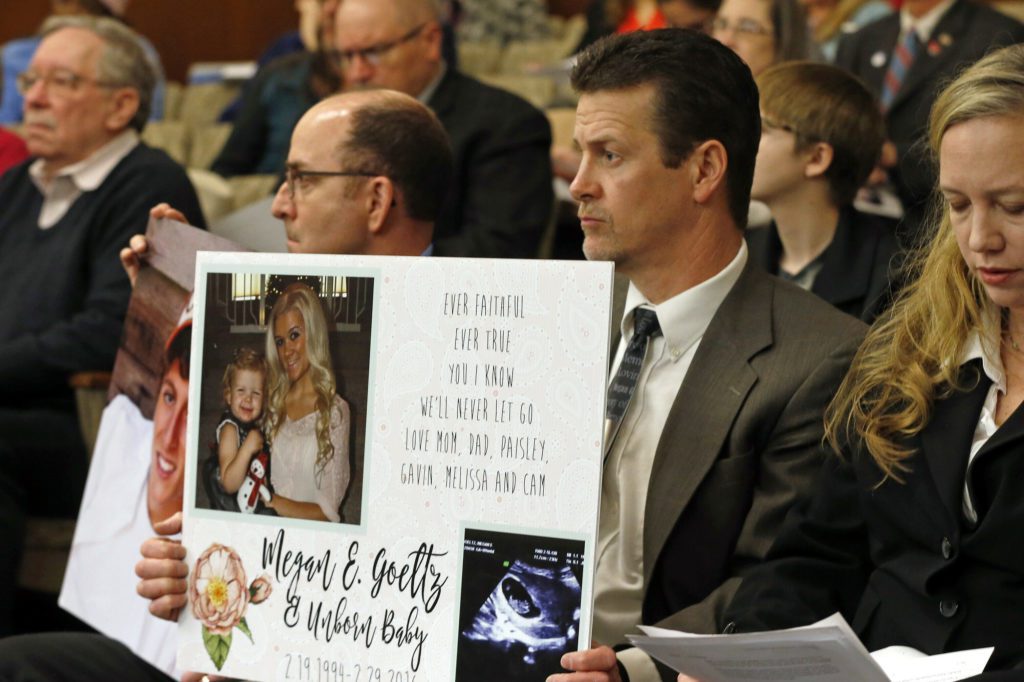
Nobody will ever be prepared to receive the worst news of their lives, especially in the case of Tom Goeltz, Vijay Dixit, and Greg and Amy LaVallee, who all lost their children to distracted drivers. Goeltz was sitting in his living room when he received a call that would change his life; a distracted driver had crossed over two lanes of traffic, taking the life of not only his daughter Megan, but his unborn grandson as well. Phillip LaVallee ran cross country at South Dakota State University on a scholarship, going for runs over the summer at home where he stayed with his family. It was on one of these runs that a distracted driver crossed over the center line and struck him from behind. Similarly, Dixit lost his daughter Shreya, a sophomore at the University of Wisconsin- Madison, when her friend became distracted behind the wheel. Shreya was the only one in the car who did not survive the crash. Phillip, Shreya, and Megan were the center of their parents’ worlds, and when their lives were suddenly taken from them, Greg and Amy, Vijay, and Tom were struck with unimaginable grief.
Fueling Action Out of Loss
However, they decided to turn their grief into meaningful action, hoping to make a difference in the world that took their children’s lives. Their losses brought upon a need for advocacy, leading them down a path that would create significant change in distracted driving behavior. Goeltz, who works as a safety professional, gave a routine presentation two weeks after Megan’s death, switching one of the topics to distracted driving and telling a group of strangers his story: “It was hard for me to stand in front of them and talk about Megan, but it was worth it. Everyone in the session either shook my hand or gave me a hug afterwards. Some were even crying. They told me to keep talking about this and that’s exactly what I’ve done.”
Goeltz has expanded his presentations to local high schools and elementary schools, a feat that Dixit and the LaVallee’s are quite familiar with. After his daughter’s passing, Dixit established the Shreya R. Dixit Memorial Foundation, which has recently rolled out a peer-to-peer program that brings teens and elementary children together to learn about distraction-free driving. He explained that “Children have the ability to change the driving culture. With teen mentors, they can become a positive influence and develop good driving habits.” Similarly, Greg and Amy established the nonprofit organization, Just Drive, organizing community events and giving presentations to spread the safe-driving message, which Greg said “is a good way to keep talking about Phillip and keep him in my life.” While they were each on separate journeys after their losses, the LaVallees, Dixit, and Goeltz’ paths would soon cross in a new battle for advocacy: the Minnesota Hands-Free Law.
The Minnesota Hands-Free Law
These individuals came together, along with countless other families who have lost loved ones to distracted drivers, to put faces to the bill and strengthen the cause. Amy LaVallee explained it as empowering, and said, “When you’re going through something so traumatic and you’re with people who’ve experienced a similar tragedy, there’s a bond there that gives you the strength to push through and get what you need done even when it’s difficult.” Greg added, “Part of the power is that we all couldn’t be there at the same time. It was a relay where someone would pick up the baton and they’d be the focus of that hearing. That’s how we got things done. We were a team.”
This battle took place over a decade, with Goeltz and the LaVallees coming into the picture later on. Goeltz explained, “Vijay spent ten years working on it. I became involved only two years ago, but it’s felt like ten.” Dixit elaborated on this, saying, “It was a continuous battle all the way until the end. We had a multi-pronged attack on the epidemic. We had families bring in pictures of their lost loved ones and sit in the galleries. We collaborated with other organizations to get the community involved. Despite these efforts and organizations in full support of the bill, there were still some legislators who didn’t listen, who did not get it done.”
It wasn’t until a recent change in the Minnesota government that allowed the bill to finally become a law. “We never gave up,” Dixit explained, “the people were listening to us more than the legislators. They gave us hope, but we were still on edge up until the day the bill was signed.” The Minnesota Hands-Free Law bans the handheld use of cell phones, and drivers who wish to use their phones must use alternatives like voice commands. If a driver is caught using or holding their phone, the first offense will incur a $50 ticket and future offenses will result in a $275 ticket. This law aims to make the roads safer, according to the Minnesota Office of Traffic Safety which claims that, “In 12 of 15 states with hands-free laws, traffic fatalities have decreased by an average of 15 percent.”
A Huge Success But, More to be Done
While this is a huge success in the battle against distracted driving, the LaVallees, Dixit, and Goeltz believe that there is much more work to be done. “Let us not be fooled that we are now distraction free. Hands free is not distraction free or risk free. This is just the beginning of a huge journey to ending distraction related deaths,” Dixit said. Goeltz agreed, adding that “It’s better to not use the phone at all. This is the only way for people to truly protect themselves. Nothing is more important than human life.”
In the future, they all wish to see more penalties for distracted driving. The first offense is $50, which Greg claims, “is not a true motivator.” The driver responsible for Shreya’s death faced a $100 fine, yet no price can be placed on human life or the grief their families will suffer through. However, the ultimate goal is to eliminate distraction related deaths completely by banning cell phones in cars. “How many people will it take before the government wakes up? It’s hard for us to get out there and share our stories. The pain is still as fresh as the day I got that phone call. But we are speaking for thousands of people who cannot, and there is still so much work to be done,” explained Goeltz.
As for justice, Amy believes that, “There is nothing that would bring justice, but if we can save lives by getting people to realize that distracted driving is preventable, well, that’s a start.” Goeltz added that “You can put people away for life and we still wouldn’t feel like justice is served. I’m not sure justice will ever come to us, but we can start taking steps like this bill to get to the day where no one will have to go through what we did.” He continued, “I want to meet my grandson one day. I want to make a difference in this world and I think I’ve found a way to do that.”
Go to the Minnesota Department of Public Safety website for more information about the Minnesota Hands-Free Law.
Watch “The Stage: Shreya’s Unfinished Story" produced by the Travelers Insurance Company.
________________
 *Melanie Riehl is a sophomore Communications and Media Studies student at Fordham University at Lincoln Center. She serves as a Copy Editor on the executive board of Fordham’s student newspaper, The Observer.
*Melanie Riehl is a sophomore Communications and Media Studies student at Fordham University at Lincoln Center. She serves as a Copy Editor on the executive board of Fordham’s student newspaper, The Observer.



